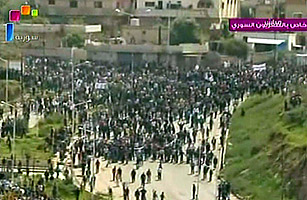
A man in a white shirt lies motionless, apparently dead, on an otherwise empty road, his arms and legs splayed at awkward angles. Intense gunfire crackles as four black-clad anti-riot policemen in helmets and shields run up to the body, several beat it with their batons before dragging it along the asphalt by its feet. The mobile phone footage zooms out to show hundreds of policemen deployed along the street, allegedly in the southern Syrian city of Dara’a, where anti-government protests first erupted less than a month ago. A voice off camera screams “Let the people see!” but the body has disappeared from view.
It’s a gruesome episode to be sure, but one that may have far-reaching consequences, given that the motionless man in the white shirt is reportedly Mohammad Abdurazak al-Sharaa, the cousin of Vice-President Farouk al-Sharaa. The claim was conveyed by Radwan Ziadeh, a Washington-based Syrian dissident and visiting scholar at The Institute for Middle East Studies at George Washington University. Ziadeh says al-Sharaa’s family personally confirmed the identity of the dead man to him. He was killed on Friday April 8. “He was very close [to the vice president], and I think it will have huge implications,” Ziadeh says.
The National Progressive Front, a body dominated by the Ba’ath Party of President Bashar al-Assad, has ominously warned that “there is no room for complacency in dealing with these gangs,” suggesting a possible uptick in violence. The regime “distinguishes between the reform aspirations of citizens and their legitimate demands” and conspirators trying to exploit “the changes taking place in the region to serve their hostile plots and undermine Syria’s stances … against hegemonic interests and Israeli expansion policies.”
The death toll is also a matter of debate, even among human rights organizations. It stands at 200, according to a key Syrian rights group known as the Damascus Declaration, while HRW has a much lower figure of 130.
The confusion may be deliberate, according to a typed, three-page document stamped “top secret” and allegedly issued by the Syrian intelligence agency, dated March 23, 2011 and viewed by TIME. It is now posted on the Syrian Revolution 2011 Facebook page. The authenticity of the paper and its contents is impossible to verify. It summarizes a meeting of a 10-person security committee on March 23, a week after protests kicked off in earnest in Dara’a. It says the media must be prevented access to flashpoint towns, and that false witnesses should be paraded before the press to recount testimony that “should contain contradictions and lies that we can expose in the state media and discount to destroy the credibility of the protesters.”